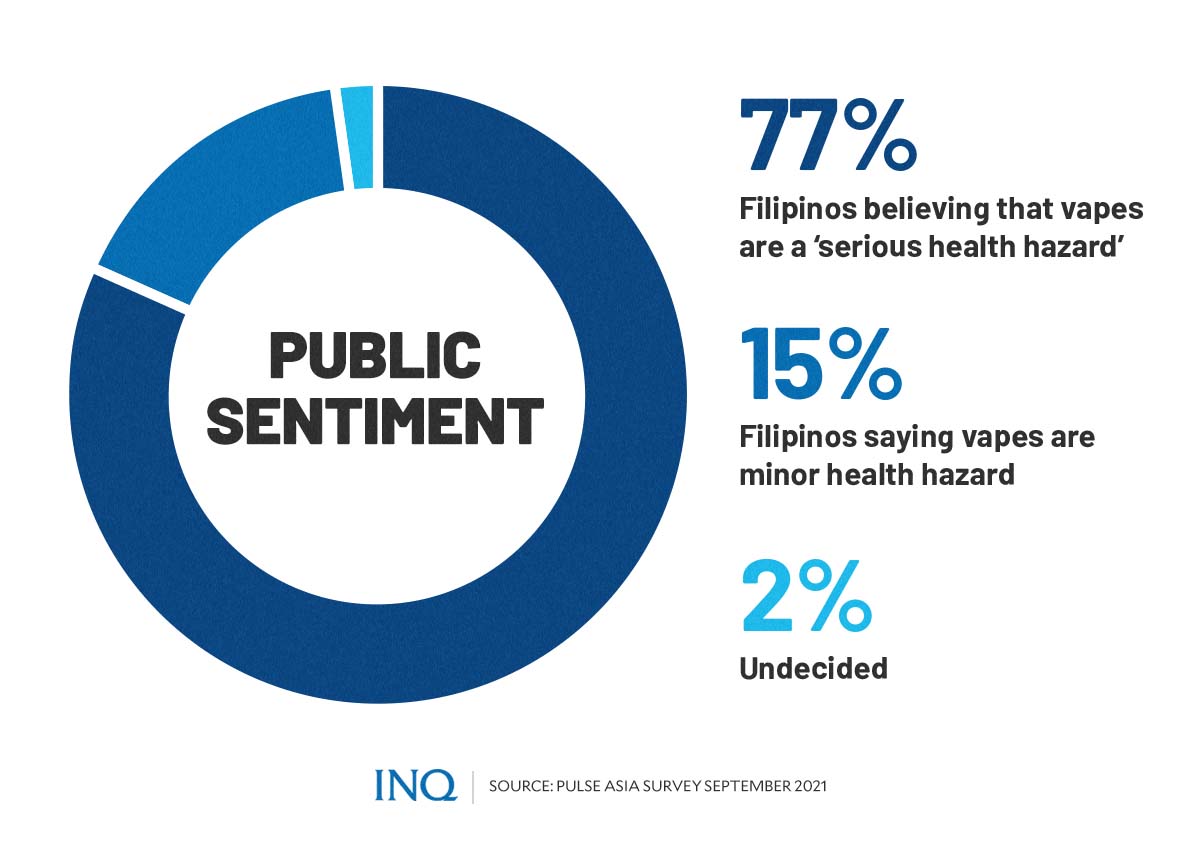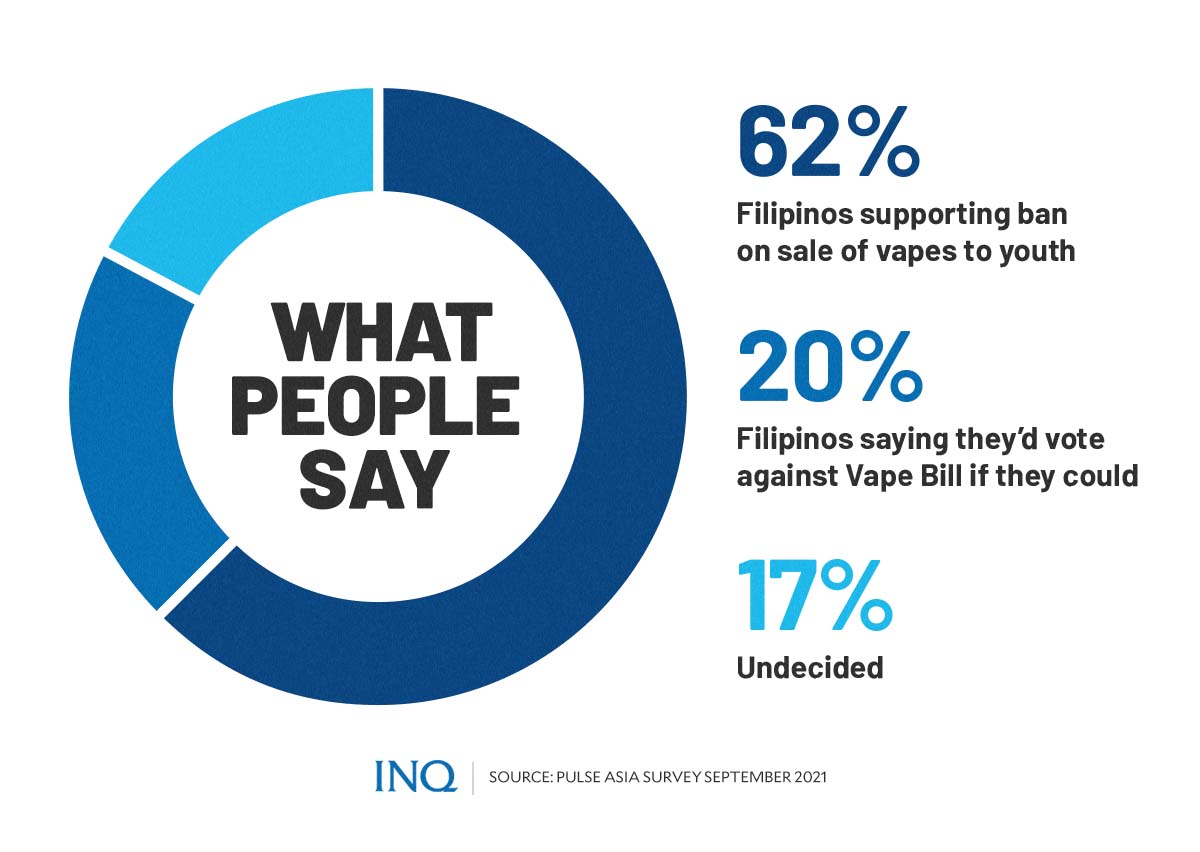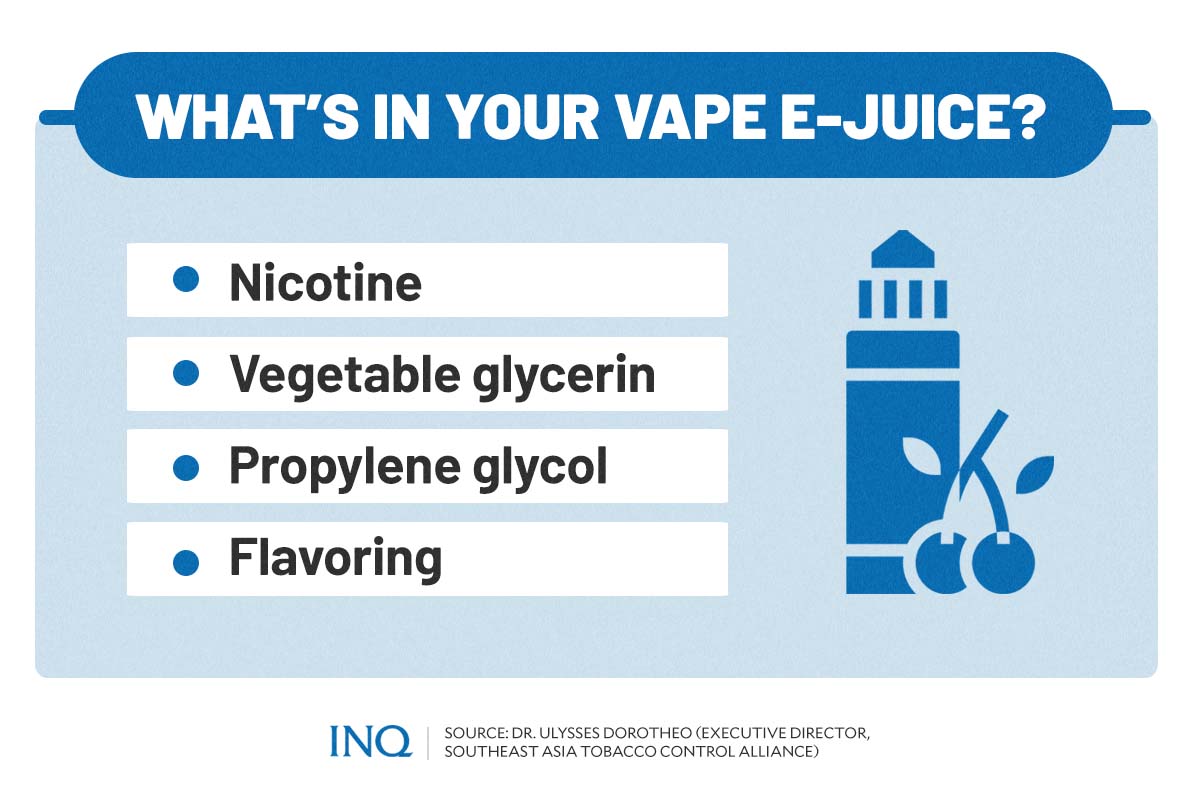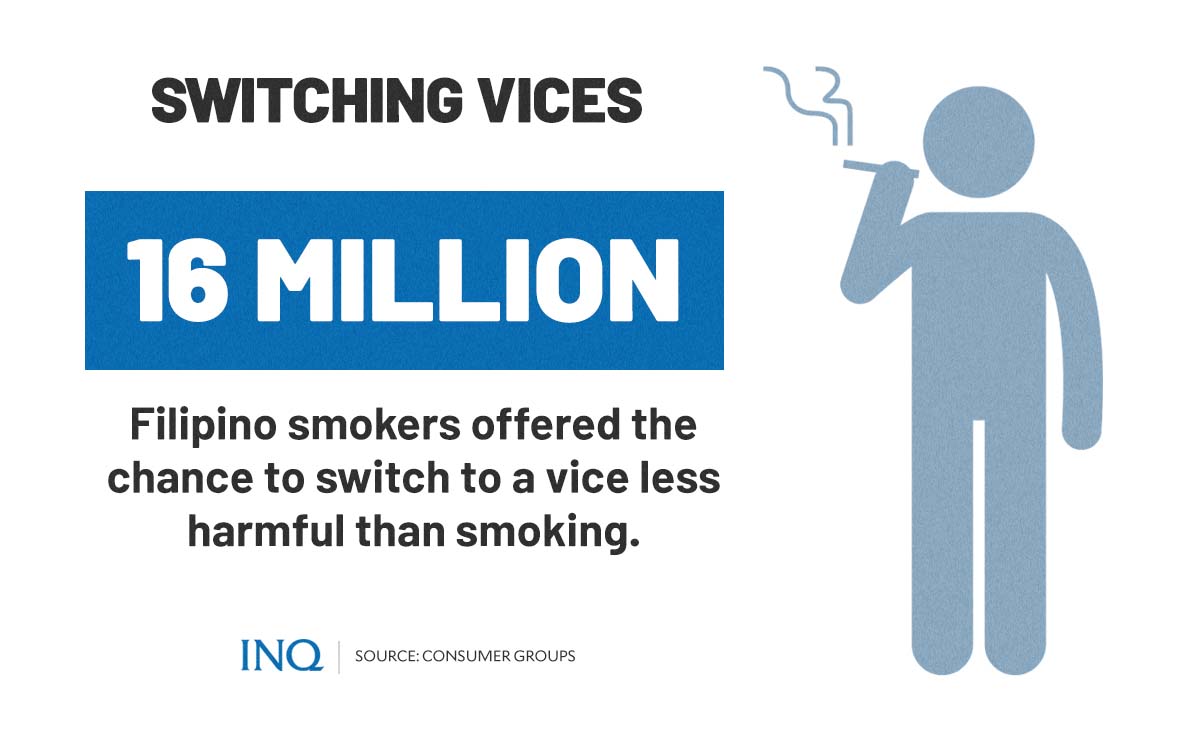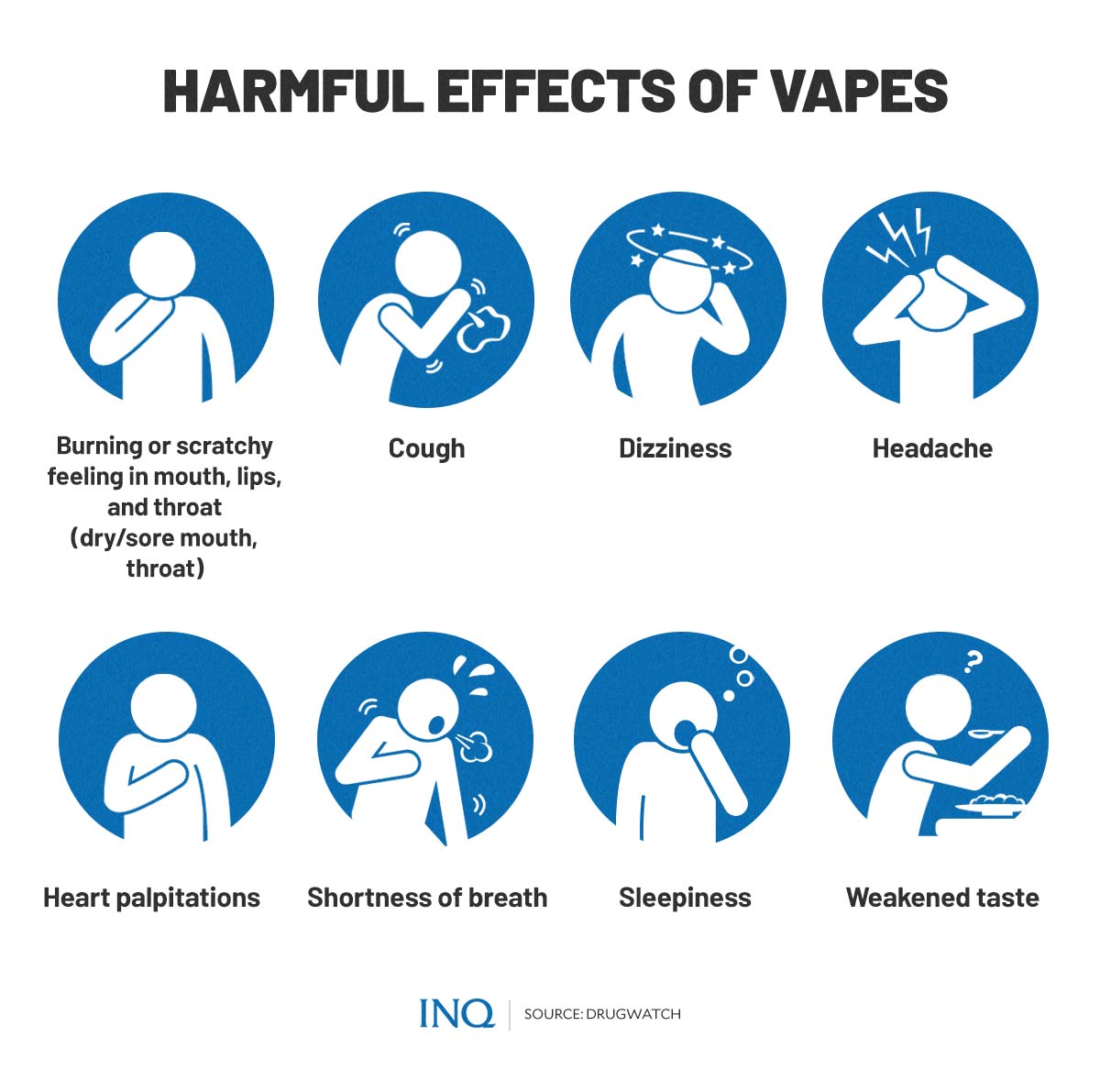Vape Bill: Unresolved debate on vaping’s risks, benefits now to reach Duterte’s table
(Second of two parts)
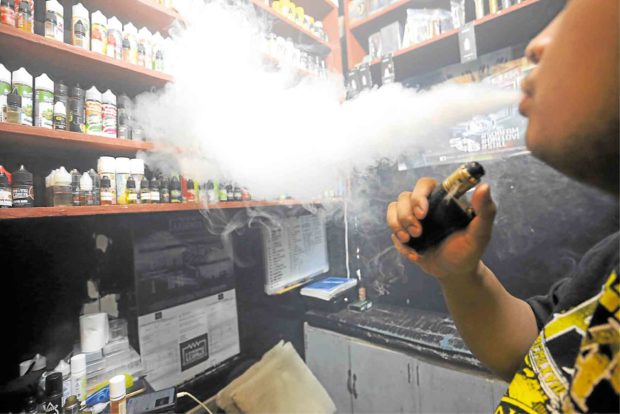
RESTRICTED USE A customer checks out vape flavors at a store in Pasay City, which has banned vaping in public areas. JOAN BONDOC/PHILIPPINE DAILY INQUIRER FILE PHOTO
MANILA, Philippines—While President Rodrigo Duterte has yet to decide on the future of the proposed Vaporized Nicotine Products Regulation Act, or the Vape Bill, proponents of the bill and endorsers of vaping push for its passage amid an outcry from health experts and youth protection advocates.
The pending Vape Bill, which passed the House of Representatives and the Senate—with both versions reconciled by a bicameral conference committee—seeks to regulate vaporized nicotine (vape) and non-nicotine products as well as novel tobacco products.
The bill is currently up for Duterte’s signature after the House of Representatives ratified in January the report of the bicameral conference committee which reconciled the disagreeing provisions of Senate Bill No. 2239 and House Bill No. 9007.
On April 19, however, acting Presidential Spokesperson Martin Andanar said in a press briefing that Malacañang records office has yet to receive a copy of the Vape bill.
The bill, according to Senate President Protempore Ralph Recto, is also expected to encourage smokers to shift from unhealthy cigarettes to “alternative less harmful products”, such as vape or electronic cigarettes (e-cigarettes).
However, certain provisions in the bill have been questioned by no less than the Department of Health (DOH), Department of Education (DepEd), as well as medical experts, and groups of concerned citizens.
Those against the passage of the bill pointed out that it might weaken the already existing measures on smoking—including RA 11346, RA 11467, and EO No. 106—and the grim impact of the bill on Filipino youth.
Among the things pointed out were the lowering of the age of access to vape from 21 to 18 years old, as well as allowing more flavors—which experts said might further entice or appeal to children and non-smokers.
READ: As Duterte action awaited on Vape Bill, experts paint grim scenario for PH youth
Still, despite calls to veto the vape bill, supporters urge Duterte to sign it into law, citing what they believed as the advantages of the pending bill. Some supporters have also previously answered some claims made by opposing groups.
Supporters counter complaints
Although the bill lowers the age of access to vape or vapor products from 21—as currently stated by RA 11467 and EO 106—to 18 years old, Recto said the bill “is never intended to adopt a new lifestyle, especially for minors, who are prohibited from having access to these products.”
READ: Senate ratifies bicam report on vape bill
Contrary to previous claims by the DOH, DepEd, and medical experts that more youth will be put at risk once the bill is passed into law, House Deputy Speaker Rodent Marcoleta said the Vape Bill has ample safeguards for youth protection.
READ: DOH: Vaping puts young Filipinos at risk
“Out of the 30 provisions of the entire bill, half of it is for prohibition, especially (for) minors who should not be given access to these products,” he said.
The health and education departments, as well as groups of medical experts, have also aired concerns on a provision in the bill, which only restricts those with “flavor descriptors” that are “proven to unduly appeal” to youth.
This was in comparison to existing laws, which banned vape flavors other than plain tobacco or menthol—in an effort to prevent enticing minors to use vape.
“The flavors, that’s why we don’t want them, it’s not because of the injury, it’s because it entices children, it was developed for kids. Because no adult will smoke blueberry flavor or ice cream,” Dr. Rolando Enrique “Eric” Domingo, former director-general of the Food and Drug Administration (FDA), told VERA Files.
Flavors such as cotton candy, chocolate, or any fruity flavors are just among the over 15,000 vape flavors currently available and accessible in the market—which Dr. Ulysses Dorotheo, executive director of the multi-sectoral Southeast Asia Tobacco Control Alliance (SEATCA), said are marketed as “beginner-friendly” by some retailers.
To address such concerns, Nueva Ecija Rep. Estrellita Suansing, one of the authors of the Vape Bill, said they are cognizant of the concerns related to flavors when they drafted the bill.
“The Vape Bill is very restrictive when it comes to flavors. We understand that flavors should not be used to target minors and non-smokers,” she said.
Rep. Sharon Garin, chairperson of the House Committee for Economic Affairs and a member of the House bicameral conference committee, said the pending Vape Bill complements existing regulations such as RA 11467 and EO 106.
“With the passage of the Vape Bill, we are solidifying the provisions of RA 11467 and Executive Order 106 issued by President Rodrigo Duterte and in particular, banning the sale of e-cigarettes with flavors other than menthol and tobacco,” said Garin.
“We made sure that every aspect of regulation for these products were included in the bill including the manufacture, importation, sale, distribution, use and advertising. We did not leave any stone unturned and even included the provisions under EO 106 issued by the President,” she continued.
“More importantly, we made sure that this bill has teeth for enforcement by including severe penalties for violators thereof – something that we don’t have at present under RA 11467 and EO 106,” the lawmaker added.
In a statement, Sen. Pia Cayetano, who sponsored RA 11467, urged proponents of the bill to refrain from claiming that the measure will be beneficial to the youth—which the senator described as a “blatant lie.”
“The proponents say that their bill [solidifies] the provisions of RA 11467 and Executive Order 106 by strengthening the flavor ban on e-cigarettes. If that was the case, then they should have just kept the provision of the Sin Tax Act – which limits vape flavors to plain tobacco and plain menthol only,” the senator said.
“Instead, they provided wording that allows hundreds and thousands of flavors to flood the market. How will they even regulate all these flavors? In the US, 55,000 flavors were rejected by the US FDA for failing to provide evidence that they protect public health,” she added.
Not peddlers of ‘fake news’
Last month, Garin also reacted to claims by the health and education sectors—both of which opposed the Vape Bill—and said that the opposing groups spread “misinformation” about the bill.
“I don’t understand the misinformation being spread by some sectors that this bill overturns the ban on the use of flavors that appeal to minors and other restrictions under EO 106. This is fake news. Except for the age requirement, the Vape Bill does not repeal the provisions of RA 11467 and EO 106. It actually strengthens it,” Garin said.
She also called out what she described as misleading reports, saying that the Food and Drug Administration (FDA) will continue to have exclusive jurisdiction and regulate vapor products with health claims under the Vape Bill, while the Department of Trade and Industry will regulate vapor products without health claims.
In a statement, members of the Sin Tax Coalition slammed the lawmaker for calling sectors who oppose the bills as bearers of fake news.
“On the contrary, the supporters of the Vape Bill are the ones using false information and spreading unverified and controverted studies to favor their narrative that the Vape Bill is pro-youth and pro-health,” the statement read.
The group further asked Garin to refrain from spreading “false news.”
“The Vape Bill is far from being a harm reduction strategy. The bill is what we should call fake news. Anti-health politicians claim that the Vape Bill will finally regulate vaping. That is patently false. The truth is, vaping has always been regulated by the Food and Drug Authority (FDA) through Republic Act No. 11467 and Executive Order No. 106. The new Vape Bill does not ‘strengthen’ regulation as claimed by Representative Garin.“
“We wish that our anti-health politicians conduct further research before issuing statements that turn out to be false.”
Life-saving?
Supporters of the Vape Bill said that once approved, it will give access to around 16 million Filipino smokers to alternatives to smoking—such as vape, e-cigarettes, or heated tobacco products (HTPs)—while providing strict safeguards to ensure that minors and non-smokers do not have access to these products.
“The logical conclusion is that vapor products will save the lives of 16 million Filipino smokers or at the very least reduce their health risks. Therefore, regulation and not prohibition is key. This is what the vape bill seeks to do,” said Dr. Fernandez.
READ: Opposition to Vape Bill may exacerbate smoking, top Filipino doctors say
Dr. Arleen Reyes, past president of the Philippine Dental Association, echoed Dr. Fernandez’s sentiments, adding that banning vapor products could only lead to a worse smoking problem in the country.
“I don’t agree that we should ban vapor products. If we do that, we will lose this public health opportunity to end the smoking epidemic. Let’s not forget, smoking kills close to 100,000 Filipino smokers every year. That is around 300 Filipinos per day. A ban on vapor products only perpetuates the use of cigarettes that endangers the lives of 16 million Filipino smokers,” said Dr. Reyes.
Former smokers also said vapor products have helped them throw away their habit of smoking tobacco products.
“It took me a very long time to stop smoking. Without vapor products, I would not have been able to fully stop. The reality is many smokers will try to stop smoking, but will never be successful. That is what the WHO data says,” said Dr. Telesforo Gana, past president of the Philippine Urological Association and past chair of the Philippine Board of Urology.
“Smoker’s lives matter too. We should not look at them as statistics. We need to have pragmatic solution to end the smoking epidemic. I hope the Vape Bill can be that solution so we can save the lives of 16 million Filipino smokers,” he added.
Vape users who supported the bill also believe that using vapor products are far less harmful than smoking cigarettes, thus making it a better alternative, especially for those who are trying to quit smoking.
“The science supporting vaping and heated tobacco as less harmful alternatives to cigarettes can’t be denied anymore. Progressive countries including the US, the UK, New Zealand and many more have embraced these non-combustible alternatives, following extensive scrutiny by their respective public health institutions,” said Joaqui Gallardo, spokesman of Vaper AKO.
“More and more adult smokers who had no success in quitting smoking before have finally found what works for them to kick the deadly habit. A UK study concluded that non-combustible alternatives are twice as effective compared to nicotine replacement therapy in helping smokers quit,” said Anton Israel, president of the Nicotine Consumers Union of the Philippines (NCUP).
Israel added that “more than a million papers have already left smoking behind with the help of vapes and heated tobacco products.”
READ: Vape bill gives 16 million Filipinos a chance to evade harm from smoking
Marcoleta said the passage of the bill is expected to result in a drop in the number of smokers in the Philippines.
“As seen in other countries, smoke-free alternatives significantly contributed to the drop in the number of smokers. This is our gift, our legacy to the Filipino people,” he said.
Still very dangerous
The DOH emphasized that vapor products “are harmful and not risk-free and should be regulated as health products due to their toxic substances and effects”
“Vape liquids and its emission contain chemicals such as nicotine, propylene glycol, carbonyls, and carbon monoxide that are either addictive, toxic or can cause cancer,” the health department said.
“Additionally, studies have shown vape use increases the risk of using other known addictive substances such as cigarette use, alcoholism and even marijuana use. There is also growing evidence of the harmful effects of using vapes both to the user and those exposed to its emissions, including its potential to cause cardiovascular diseases, respiratory problems and explosion injuries,” the department added.
On its website, the World Health Organization (WHO) stated that Electronic Nicotine Delivery Systems (ENDS), such as e-cigarettes, may contain varying amounts of nicotine and harmful emissions.
“E-cigarette emissions typically contain nicotine and other toxic substances that are harmful to both users, and non-users who are exposed to the aerosols secondhand. Some products claiming to be nicotine-free have been found to contain nicotine,” said WHO.
“Evidence reveals that these products are harmful to health and are not safe. However, it is too early to provide a clear answer on the long-term impact of using them or being exposed to them,” it added.
Similar to smoking cigarettes, ENDS users may also have a high risk of heart and lung disorders. They can also pose significant risks to pregnant women and non-smokers.
Moreover, WHO warned that children may swallow liquid used in ENDS such as vape or e-cigarettes. Instances of devices leaking as well as injuries such as burns through fires and explosions have also been associated with ENDS.
Are e-cigarettes or vapor products more or less dangerous than conventional tobacco cigarettes?
“It is difficult to generalize on the risk to health of ENDS as compared with cigarettes or other tobacco products, as this is contingent on a range of factors.
Both tobacco products and ENDS pose risks to health.,” said WHO.
“The safest approach is not to use either,” it added.
When asked about the role of ENDS in smoking cessation, WHO said:
“The scientific evidence regarding the effectiveness of ENDS as a smoking cessation aid is still being debated. To date, in part due to the diversity of ENDS products and the low certainty surrounding many studies, the potential for ENDS to play a role as a population-level tobacco cessation intervention is unclear.”
To “truly help” tobacco users quit and strengthen global tobacco control, WHO advised governments to “scale up policies and interventions that we know work.”
These include tried and tested interventions including:
- Brief advice from health professionals
- National toll-free quit lines
- Cessation interventions delivered via mobile text messaging
- Promoting nicotine replacement therapies and non-nicotine pharmacotherapies for cessation in areas where it is economically feasible.
Harmful impact
A commissioned survey conducted by Pulse Asia last year showed that 8 out of 10 Filipinos, or 77 percent of 1,200 adult respondents, believe that e-cigarettes pose a “serious health hazard” to users.
At least 15 percent said it is a minor health hazard, while two percent said it is not.
But what are these health hazards exactly?
According to a 2021 study published in International Journal of Environmental Research and Public Health, around 40 percent of e-cigarette users reported experiencing vaping side effects on a daily basis.
Some of the common e-cigarette side effects include:
- burning or scratchy feeling in mouth, lips, and throat
- cough
- dizziness
- dry/sore mouth and throat
- headache
- heart palpitations
- shortness of breath
- sleepiness
- weakened taste
Vaping, according to consumer advocacy organization Drugwatch, can also cause serious side effects, albeit rare, such as:
- nicotine addiction
- severe lung injury
- seizures
- cryptogenic organizing pneumonia (COP), formerly known as idiopathic bronchiolitis obliterates with organizing pneumonia (BOOP)
- popcorn lung
- strokes
- heart attacks
In November 2019, the DOH received an official report on the first case of E-cigarette or Vape-Associated Lung Injury (EVALI) from a private pediatric pulmonologist based in the Visayas.
According to the case report, the patient was a 16-year-old female adolescent who had been using e-cigarettes for six months “while concurrently consuming combustible cigarettes, referred to as ‘dual use’.”
The patient, who was admitted to hospital in October that year, “initially presented with sudden-onset severe shortness of breath, required oxygen supplementation and ICU admission. Upon admission, the clinical impression was initially considered to be infectious in nature.”
“All e-cigarette users should seek immediate medical help, and ask their doctors for ways to quit these harmful products. No e-cigarette product should be accessible to young children and adolescents, who are uniquely susceptible to the harms of e-cigarettes and nicotine. I urge non-users not to even try e-cigarettes at all,” then Health Undersecretary Rolando Enrique Domingo stated.
The US Centers for Disease Control and Prevention (CDC) also emphasized that e-cigarette aerosol is “not harmless ‘water vapor’.”
The e-cigarette aerosol that users breathe from the device and exhale can contain harmful and potentially harmful substances, including:
- nicotine
- ultrafine particles that can be inhaled deep into the lungs
- flavorings such as diacetyl, a chemical linked to a serious lung disease
- volatile organic compounds
- cancer-causing chemicals
- heavy metals such as nickel, tin, and lead
“The aerosol that users inhale and exhale from e-cigarettes can expose both themselves and bystanders to harmful substances,” the US CDC said.
“It is difficult for consumers to know what e-cigarette products contain. For example, some e-cigarettes marketed as containing zero percent nicotine have been found to contain nicotine.”
